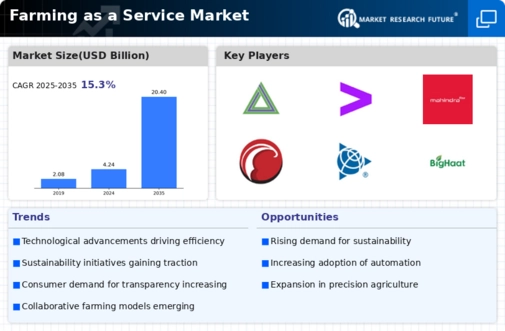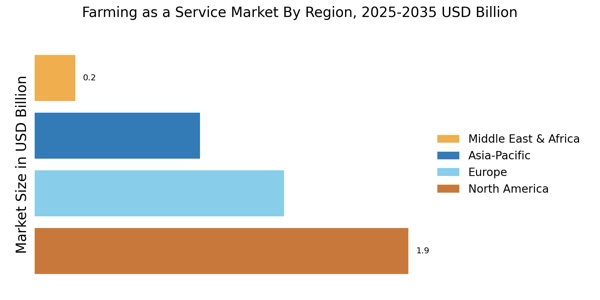Access to Capital
Access to capital is a critical driver for the Farming as a Service Market, particularly for smallholder farmers who often face financial constraints. The rise of fintech solutions and microfinance options has made it easier for farmers to obtain funding for agricultural services. This financial support enables them to invest in advanced farming technologies and services that enhance productivity. Recent data indicates that the agricultural financing market is expected to reach USD 200 billion by 2026, reflecting a growing recognition of the importance of financial resources in agriculture. As access to capital improves, more farmers are likely to engage with Farming as a Service Market providers, thereby expanding the market. This trend suggests that financial inclusivity will play a pivotal role in the growth of the Farming as a Service Market.
Sustainability Initiatives
Sustainability is becoming a cornerstone of the Farming as a Service Market, as consumers and governments alike prioritize environmentally friendly practices. The increasing awareness of climate change and its impact on agriculture has led to a demand for sustainable farming solutions. Services that promote organic farming, reduce chemical usage, and enhance soil health are gaining traction. Recent statistics suggest that sustainable agriculture practices can lead to a 30% increase in crop yields while minimizing environmental impact. This growing emphasis on sustainability is likely to drive the adoption of Farming as a Service Market models, as they often incorporate eco-friendly practices and technologies. Consequently, the Farming as a Service Market is poised to expand as stakeholders seek to align with sustainability goals.
Technological Advancements
The Farming as a Service Market is experiencing a surge in technological advancements that enhance agricultural productivity. Innovations such as precision agriculture, IoT devices, and AI-driven analytics are transforming traditional farming practices. These technologies enable farmers to optimize resource use, monitor crop health, and predict yields with greater accuracy. According to recent data, the adoption of smart farming technologies is projected to grow at a compound annual growth rate of over 12% in the coming years. This trend indicates a shift towards data-driven decision-making in agriculture, which is likely to drive the demand for Farming as a Service Market solutions. As farmers increasingly seek to leverage technology for efficiency, the Farming as a Service Market stands to benefit significantly from this trend.
Changing Consumer Preferences
Changing consumer preferences are significantly influencing the Farming as a Service Market. There is a noticeable shift towards locally sourced, organic, and sustainably produced food, driven by health-conscious consumers. This trend is prompting farmers to adopt practices that align with these preferences, such as organic farming and reduced pesticide use. As a result, Farming as a Service Market providers are increasingly offering tailored solutions that cater to these evolving demands. Market Research Future indicates that the organic food market is projected to grow at a rate of 10% annually, which could lead to increased demand for Farming as a Service Market offerings that support organic production. This shift in consumer behavior is likely to create new opportunities within the Farming as a Service Market.
Government Support and Policies
Government support and policies play a crucial role in shaping the Farming as a Service Market. Many governments are implementing initiatives aimed at modernizing agriculture and promoting sustainable practices. These policies often include subsidies, grants, and tax incentives for farmers who adopt innovative farming techniques and services. Recent reports indicate that government funding for agricultural technology is expected to increase by 15% over the next five years, reflecting a commitment to enhancing food security and sustainability. Such support not only encourages farmers to engage with Farming as a Service Market providers but also fosters an environment conducive to innovation. Consequently, the Farming as a Service Market is likely to benefit from favorable government policies that promote agricultural modernization.


















Leave a Comment